Digital Foundry vs. Alan Wake
American Nightmare and the PC port go under the microscope.
Two years after the launch of the original game, the once-cancelled PC version of Alan Wake has finally been released, offering the chance to witness a unique game technology at the height of its immense potential.
While the gameplay credentials of the original Xbox 360 game proved to be somewhat controversial, the engine that powers it remains an absolutely remarkable piece of work. Originally conceived as an open world "sandbox" game, the final version of Alan Wake proved to be somewhat linear, but vestiges remain of the original design - the landscape is vast, with a hugely impressive view distance, while the engine's handling of light and shadow is still quite unlike anything else we've seen on console.
But the ambition of Remedy's tech proved to be rather taxing on the fixed architecture of the Xbox 360 and the developer was seemingly forced to make a range of visual compromises. Despite operating a range of different render targets at multiple resolutions, native resolution on-screen was lowered to 960x544, with the developer deploying 4x multi-sampling anti-aliasing to smooth off the edges (earlier work in progress videos had suggested a 720p, 2x MSAA framebuffer). Performance-saving options such as screen-door inducing "alpha to coverage" and low resolution transparency buffers were implemented too, but even then, the game would often drop frames and introduce screen-tear.
Alan Wake PC offers up the exact same content as the Xbox 360 game (with DLC chapters included) but the chance to fully unlock the power of the engine is irresistible: no tearing, a locked 60FPS, quality settings ramped all the way up to 11. Just how much more spectacular can this game look when offered a surfeit of processing power? An overclocked Core i7 running at 3.33GHz in combination with NVIDIA's fearsome GTX580 produces some phenomenal results.
"Alan Wake PC gives us the chance to fully unlock the power of the engine - no tearing, a locked 60FPS, quality settings ramped all the way up to 11 - and it looks superb."
So what are the principle differences and improvements? Well, Remedy has established an excellent reputation of talking directly with the community and doesn't hold back on crucial information, and this post from Markus Maki pretty much lays out the entirety of the differences between the Xbox 360 and PC versions.
In terms of direct comparisons between the systems, the Xbox 360 game renders at low quality levels for elements such as screen-space ambient occlusion (SSAO) and volumetric light, and at medium for shadows, backdrop quality, and LOD distance. God rays are only enabled on certain scenes on 360, being disabled elsewhere while anisotropic filtering was only deployed on selected textures. Draw distance, however, is equivalent to the max setting on PC - which Maki says is down to draw calls being cheaper on the Xbox 360 architecture compared to DX9.
In terms of our own impressions, playing the PC version and then returning to the console game was an interesting experience. Alan Wake on 360 was a dark, murky experience - where technical compromises just seemed to work in the overall aesthetic. On PC with max settings, there is a surgical precision to almost every single rendering element, and clearly, obviously, everything looks a lot whole lot better. But there is the argument that with much of the grime and haze lifted, the atmosphere just isn't quite the same - and with very few (if any) improvements to the base artwork, some of the lower resolution textures are that much more noticeable too.
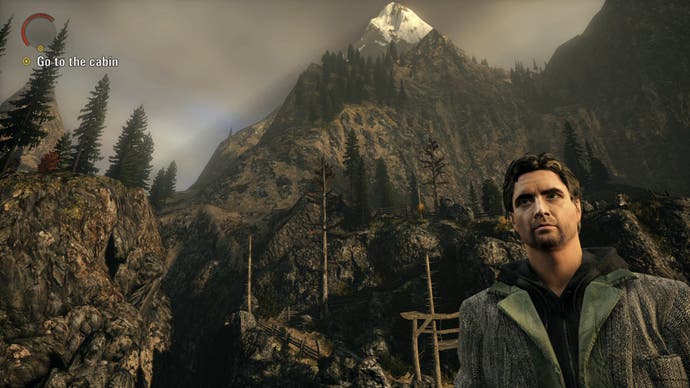

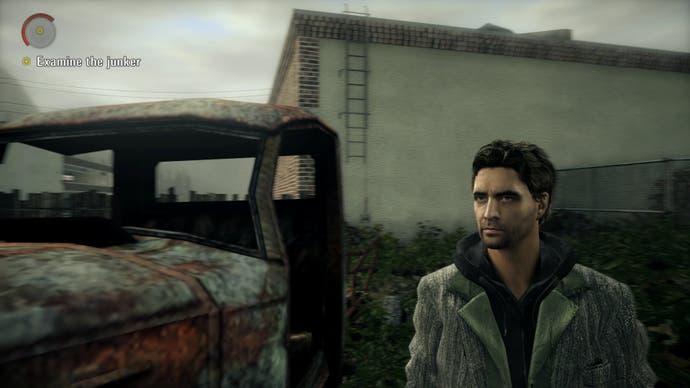
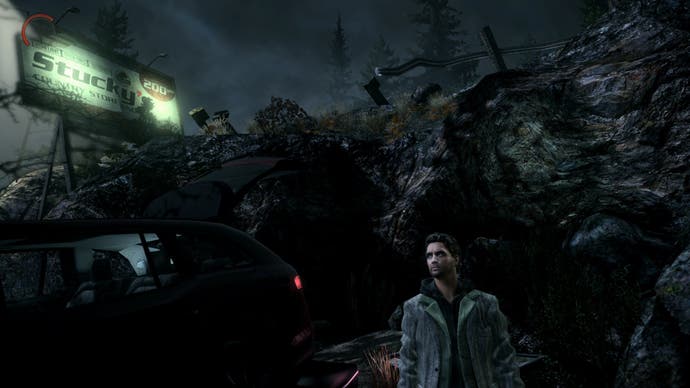
Get the Balance Right
"Alan Wake should work fine on most modern gaming PCs, but it's clear that a zero compromise approach to the visuals requires some serious horsepower."
Our (admittedly powerful) PC set-up appeared to handle 720p at 60 frames per second with almost contemptuous ease, but ramping up the resolution increases the load exponentially and not even our system could fully maintain 60 frames at 1080p. From a CPU perspective, Alan Wake should perform really well on virtually any modern quad core PC, but it's clear that a zero compromise approach to the visuals requires some serious horsepower. However, careful tweaking of the settings can still provide some useful frame-rate boosts while retaining most of the quality.
For a more extensive review of the settings and how they should be adjusted depending on your PC, Remedy's Markus Maki once again comes up with the goods with this advice on what every single setting does, and how it can affect performance.
Getting a good balance between MSAA and FXAA and being mindful of the SSAO settings can make quite a difference, but we really would recommend targeting a 60FPS update if you can - this is a game where temporal resolution can be much more impactful than the raw pixel count. To illustrate, here are a selection of Alan Wake PC gameplay clips encoded at 60 frames per second. The SD encode should work well on most PCs, while the HD video may well require a more powerful computer (or an iPad) to get best performance.
We came away rather impressed with playing Alan Wake on PC, and while we still have the same reservations about the gameplay that we had back in 2010 , a game that has always been unique and special in its own way now looks and plays better than it ever did before.
Just about the only real criticism we have about the new release comes down to the fact that at its heart it is still a console conversion - and these are comments that apply equally to many other games too. Firstly, while native resolution can be adjusted up to whatever heights the player wants, art quality doesn't scale accordingly - something we hope to see change as more developers transition to the next-gen. Secondly, video sequences are the same 720p, 30 frames per second Bink encodes we saw on Xbox 360. In a game like Alan Wake that seeks to transition seamlessly between cinematics and gameplay, a sudden drop in frame-rate or resolution really sticks out like a sore thumb.
Enter the American Nightmare
"There's an obvious resolution boost in Alan Wake's new Xbox 360 outing, and a new approach to its anti-aliasing implementation."
The release of the PC game was swiftly followed up earlier in the week by the debut of an offshoot game for the Xbox 360 Live Arcade: Alan Wake's American Nightmare, weighing in at 1200 MSP. With a short story mode and a focus on survival combat, the game features new environments, characters and weapons. It's not a sequel as such, coming across mostly as a means to show us exactly what this engine is capable of when interfaced with hordes of enemies and a range of satisfyingly destructive weaponry.
Upgrades to the Wake engine are clearly noticeable. First up, there's an obvious resolution boost, up from 960x544 to what we think (after some hints from Markus Maki) is in the region of 1120x585 - just over 25 per cent higher than it was in Alan Wake's debut outing. The increase to resolution is immediately apparent, especially on Alan himself. Quite how Remedy has achieved this particular boost is open to speculation - but it is clear that the environments this time around aren't so densely packed with detail and are obviously smaller in scale, while the rolling volumetric fog of the original game doesn't have anywhere near the same level of presence this time around.
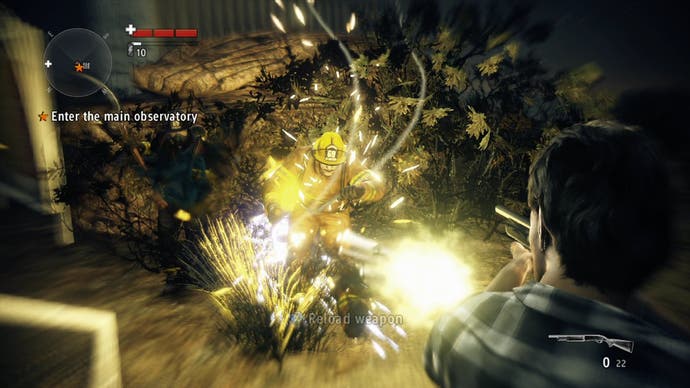
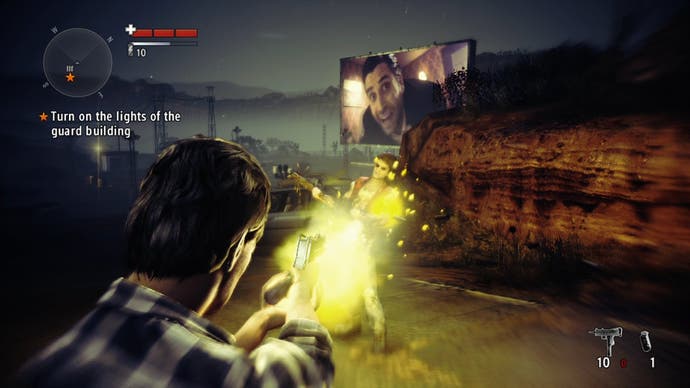
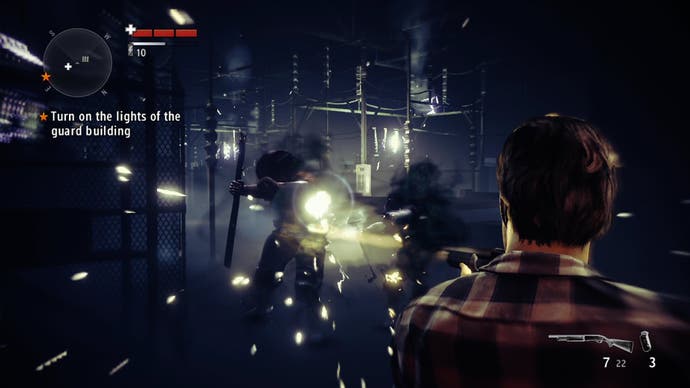
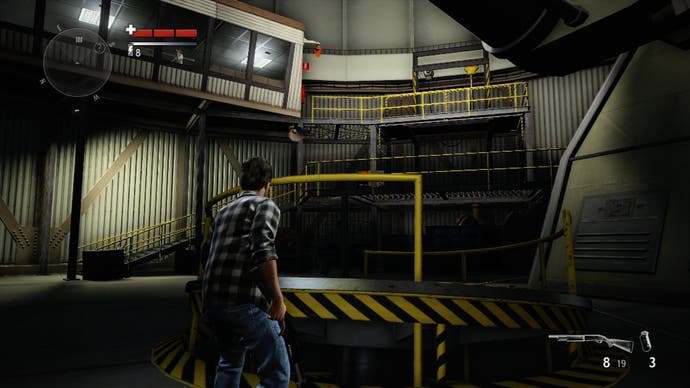
Anti-aliasing in American Nightmare has also seen some tweaks. The 4x MSAA of the original game has been retained, but Remedy also includes NVIDIA's FXAA too in addition to that. In theory, this combination should be the holy grail of edge-smoothing, but we believe that the application of the MSAA isn't as consistent as it was in the first game, while some lighting effects appear to break the FXAA. The bottom line is that while overall presentation is absolutely fine, there are still occasions where aliasing can look pretty poor - the interior of the observatory, for instance.
In terms of frame-rates, overall performance is pretty decent. On default settings, the game runs at a capped 30 frames per second with v-sync engaged, with tearing only appearing when the renderer runs over budget. The effect doesn't appear to be quite as pronounced as it was in the original Alan Wake, except during intensive combat - dynamic light sources (flares in particular) clearly give the engine a stiff work-out. Two years on, the Alan Wake engine still looks quite beautiful and the compromises Remedy has made here make sense - control remains responsive even when the engine is struggling.
Why Games Have Screen Tear
This isn't the end of the story though. Within the game options, American Nightmare offers players the chance to play with v-sync engaged, completely eliminating all tearing from the game. This offers us an intriguing look at the decisions developers make when creating their games, and why we have to put up with tearing in the first place.
"The inclusion of American Nightmare's v-sync mode clearly demonstrates why screen tear is a necessary evil in certain games."
The technical explanation is pretty straightforward: the vast majority of Xbox 360 games are double-buffered. The machine displays one frame while rendering another behind the scenes, flipping the images when the screen begins a new refresh. In a 30FPS game like Alan Wake's American Nightmare, the window is 33.33ms. Now if the image completes rendering within that time period, there's no tearing, and everything runs consistently and smoothly.
If the rendering budget is exceeded, developers face a choice. They can either flip the framebuffer mid-refresh (causing a tear on-screen between the two frames) or else they can wait until the screen refreshes again. American Nightmare offers us the chance to see how this directly impacts the gameplay experience by offering both choices to the player.
In this video we see a range of action including in-game action and like-for-like engine-driven cut-scenes. The combat sections in particular see a painful impact on performance with v-sync engaged, while the cut-scenes give us direct comparisons of just how much v-sync can impact frame-rates in a double-buffer scenario when the exact same scenes are being processed by the 360's hardware.
While we applaud Remedy in its decision to give players the choice of which mode they'd like to use, the default choice - tearing when running over the rendering budget - is the right one for this game. While American Nightmare clearly benefits in terms of visual consistency with v-sync applied, the bottom line is that the added jerkiness has a clear and obvious impact on the responsiveness of the controls. Not only that, but the frame-rate drops kick in at exactly the wrong time - during the heat of battle - when controller response is of critical importance.
But What About the Gameplay?
"In a game that revels in rendering so many dynamic light sources at any given point, it's a shame that only one - the flashlight - has any fundamental impact to the principal gameplay."
Re-visiting the original Alan Wake and delving into the American Nightmare brings us back to the findings of our original tech analysis, and with it, our thoughts on the direction Remedy has taken with the series. What began so many years ago as an ambitious open world title morphed into a game that focused on its linear narrative - and now it is has been reborn again as a solo survival shooter. It's a direction that has paid off in this smaller, more tightly focused title - but there's still a nagging feeling that there's an incredible technology here that isn't quite paying off in terms of gameplay.
At the core of the Wake games remains a concept that is incredibly rich in potential - the notion of utilising light as a weapon against the forces of darkness. However, light is only one component of the Alan Wake combat experience: it is used to break down the shields surrounding your opponents, leaving bullets and explosives to complete the job. Instead of expanding upon the first stage of the process, American Nightmare focuses on the latter: the staid, predictable weaponry of the first adventure has given way to the likes of 9mm pistols, sub-machine guns and carbines.
In combination with other tweaks to the formula (the flashlight's battery now recharges much more quickly) the combat now feels more pacey and enjoyable, but once again, the notion of using brains instead of bullets appears to have been overlooked. In a game that revels in rendering so many dynamic light sources at any given point, it's a shame that only one - the flashlight - has any fundamental impact to the principal gameplay.
What we're left with is a single mechanic that works beautifully, but has a somewhat short-lived appeal. In combination with the shortage of levels and the lack of online co-op modes (sorely missed in what is essential a Horde-style survival game), American Nightmare comes across as a fun, technically accomplished, addictive title that's well worth its asking price but in terms of concept and features it could have been so much more. That said, this XBLA release demonstrates quite clearly that Remedy is happy to experiment with its gameplay formula and with a technology as unique as the Wake engine, we'd love to see what they come up with in a full-blooded sequel.









